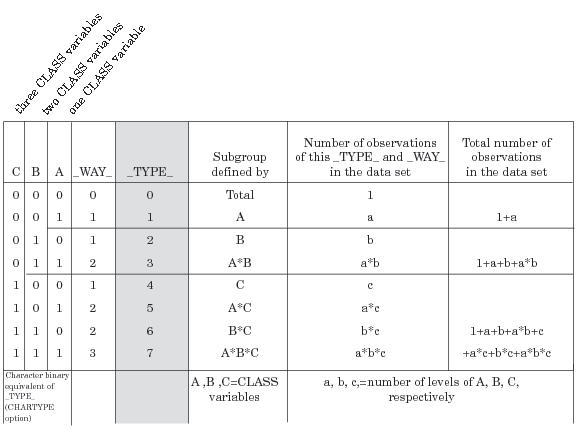MEANS Procedure
- Syntax

- Overview
- Concepts
- Using
- Results
- Examples
 Computing Specific Descriptive StatisticsComputing Descriptive Statistics with Class VariablesUsing the BY Statement with Class VariablesUsing a CLASSDATA= Data Set with Class VariablesUsing Multilabel Value Formats with Class VariablesUsing Preloaded Formats with Class VariablesComputing a Confidence Limit for the MeanComputing Output StatisticsComputing Different Output Statistics for Several VariablesComputing Output Statistics with Missing Class Variable ValuesIdentifying an Extreme Value with the Output StatisticsIdentifying the Top Three Extreme Values with the Output StatisticsUsing the STACKODSOUTPUT option to control data
Computing Specific Descriptive StatisticsComputing Descriptive Statistics with Class VariablesUsing the BY Statement with Class VariablesUsing a CLASSDATA= Data Set with Class VariablesUsing Multilabel Value Formats with Class VariablesUsing Preloaded Formats with Class VariablesComputing a Confidence Limit for the MeanComputing Output StatisticsComputing Different Output Statistics for Several VariablesComputing Output Statistics with Missing Class Variable ValuesIdentifying an Extreme Value with the Output StatisticsIdentifying the Top Three Extreme Values with the Output StatisticsUsing the STACKODSOUTPUT option to control data - References
Results: MEANS Procedure
Missing Values
PROC MEANS excludes missing values for the analysis
variables before calculating statistics. Each analysis variable is
treated individually; a missing value for an observation in one variable
does not affect the calculations for other variables. The statements
handle missing values as follows:
PROC MEANS tabulates
the number of the missing values. Before the number of missing values
are tabulated, PROC MEANS excludes observations with frequencies that
are nonpositive when you use the FREQ statement and observations with
weights that are missing or nonpositive (when you use the EXCLNPWGT
option) when you use the WEIGHT statement. To report this information
in the procedure output use the NMISS statistical keyword in the PROC
statement.
Column Width for the Output
You control the column width
for the displayed statistics with the FW= option in the PROC statement.
Unless you assign a format to a numeric class or an ID variable, PROC
MEANS uses the value of the FW= option. When you assign a format to
a numeric class or an ID variable, PROC MEANS determines the column
width directly from the format. If you use the PRELOADFMT option in
the CLASS statement, then PROC MEANS determines the column width for
a class variable from the assigned format.
The N Obs Statistic
By default when you use a CLASS
statement, PROC MEANS displays an additional statistic called N Obs.
This statistic reports the total number of observations or the sum
of the observations of the FREQ variable that PROC MEANS processes
for each class level. PROC MEANS might omit observations from this
total because of missing values in one or more class variables or
because of the effect of the EXCLUSIVE option when you use it with
the PRELOADFMT option or the CLASSDATA= option. Because of this action
and the exclusion of observations when the WEIGHT variable contains
missing values, there is not always a direct relationship between
N Obs, N, and NMISS.
Output Data Set
PROC MEANS can create one or more
output data sets. The procedure does not print the output data set.
Use PROC PRINT, PROC REPORT, or another SAS reporting tool to display
the output data set.
Note: By default the statistics
in the output data set automatically inherit the analysis variable's
format and label. However, statistics computed for N, NMISS, SUMWGT,
USS, CSS, VAR, CV, T, PROBT, PRT,SKEWNESS, and KURTOSIS do not inherit
the analysis variable's format because this format can be invalid
for these statistics. Use the NOINHERIT option in the OUTPUT statement
to prevent the other statistics from inheriting the format and label
attributes.
The value of _TYPE_
indicates which combination of the class variables PROC MEANS uses
to compute the statistics. The character value of _TYPE_ is a series
of zeros and ones, where each value of one indicates an active class
variable in the type. For example, with three class variables, PROC
MEANS represents type 1 as 001, type 5 as 101, and so on.
Usually, the output
data set contains one observation per level per type. However, if
you omit statistical keywords in the OUTPUT statement, then the output
data set contains five observations per level (six if you specify
a WEIGHT variable). Therefore, the total number of observations in
the output data set is equal to the sum of the levels for all the
types that you request multiplied by 1, 5, or 6, whichever is applicable.
If you omit the CLASS
statement (_TYPE_= 0), then there is always exactly one level of output
per BY group. If you use a CLASS statement, then the number of levels
for each type that you request has an upper bound equal to the number
of observations in the input data set. By default, PROC MEANS generates
all possible types. In this case the total number of levels for each
BY group has an upper bound equal to
where  is the number of class variables and
is the number of class variables and  is the number of observations for the given BY
group in the input data set and
is the number of observations for the given BY
group in the input data set and  is 1, 5, or 6.
is 1, 5, or 6.
 is the number of class variables and
is the number of class variables and  is the number of observations for the given BY
group in the input data set and
is the number of observations for the given BY
group in the input data set and  is 1, 5, or 6.
is 1, 5, or 6.
PROC MEANS determines
the actual number of levels for a given type from the number of unique
combinations of each active class variable. A single level consists
of all input observations whose formatted class values match.

